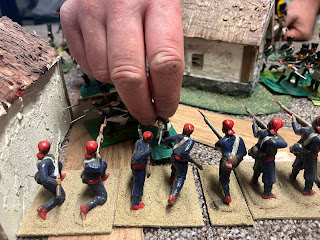10 Years ago, we played a first Russo-Ottoman campaign that ended in a Russian victory. So many years later, we play a follow up campaign. The start was days before the war in Ukrain started, so it was at the beginning a bit uncomfortable playing with a Russian army, but after all it is only a game.
The map we use is based on google maps view of the region that was the scene of the historical war of 1806-1812.
Our new campaign : After the victory at Glavinitsa (link), a 6-month truce was concluded, during which the Ottomans gave up Sillistra and a few more towns. The ceasefire is over, both sides have strengthened and a number of commanders have been replaced.The campaign is with 3 Russian and 4 Ottoman players, each of which has a number of brigades of infantry and/or cavalry.
New to our campaigns is the use of prestige points. Each player starts with 100 points. Prestige points can be gained or lost, depending on the mission, actions and the consequences of the battles.The player with the most prestige after the campaign has ended is the winner.
Day 1 saw the armies taking positions, and soon a number of brigades found enemy counterparts.
Day 2 was foggy and that had a major impact on 2 encounters, a small one in Opaka and a bigger one in Razgrad.
We play with "About Bonaparte" wargame rule from Caliver Books. The rule originated in our club.
In Opaka the Russians attacked, in Razgrad the Russians defended.
Opaka
In Opaka, the Russians attacked with 2 brigades, the first of 2 battalions, the second of 4 battalions against an Ottoman brigade of 2 batlions (New Army) units supported by 2 batteries, 1 of which was in a redoubt. The fog was very thick, so the artillery was silent until the Russians got close, although the fog was already beginning to lift.
The artillery combined with musket fire proved lethal to the 1st Russian Brigade at close range. However, a first battalion of the Ottomans was driven off the table. The Russians penetrated Opaka, but just then a brigade was reinforced with 2 battalions of irregular Moldavians and 2 units of light cavalry. 2 battalions of the Russians went into square.
The light cavalry attacked and the Moldavians also attacked from marching column. A Russian assault column was also attacked by the cavalry. The first Russian brigade had to withdraw with both battalions and an officer was also killed. Battalions of the 2nd Brigade also began to take losses. Unfortunately for the Ottomans, the New Army's second battalion was also pushed off the table with flags. Although it was difficult for the Russians, the Ottoman commander decided to withdraw and not endanger his artillery.
The Russians had Opaka in their hands, but the cost had been very heavy.
Razgrad
Here the fog was less thick at the start and almost disappeared towards the end of the battle.
The Russians were entrenched in Razgrad behind a parapet for 2 units. There were 3 brigades present, a total of 8 battalions with artillery and cavalry support. On the Ottoman side there were 2 infantry brigades with a total of 6 battalions and 1 brigade of cavalry. The Ottoman skirmish units caught sight of these after a few moves, and the Janissaries also saw the reinforcements. The latter went on the attack, while the skirmishers fired almost the entire battle on the entrenched grenadiers. An attack by the Janissaries was repelled, followed by a counter-attack by the Grenadiers. The Janissaries had to retreat, the grenadier on their turn, were driven back by skimish fire. The skirmisher inflicted also losses on the battery that was not in cover. The Russian hussars attacked one of the medium cavalry units of the Ottomans and left the field with heavy casualties. The Russian reserves now had to cover the left flank. One battalion ran into trouble from skirmish fire and was eventually destroyed. An attack by the Ottoman contact infantry penetrated across the parapet, a battle of several turns ensued with losses on both sides, but the ottoman unit was eventually annihilated. The Russians had a hard time but the Ottomans were just short of infantry. The Wallachian reinforcements arrived late, their infantry was to far to come into action, but the heavy cavalry was still able to attack their left flank against the Russian jägers in skirmish. The result was not such as to force the Russians to retreat. It was getting dark and the Ottomans had no prospect of a decisive breakthrough, here again a narrow Russian victory, with many losses.





























Such a colorful, exotic period! I have 54mm Napoleonic Russians, but no Turks. You make it very tempting.
ReplyDeletethanks Nick, part of my Ottomans are converted ECW ACTA figures.
ReplyDelete